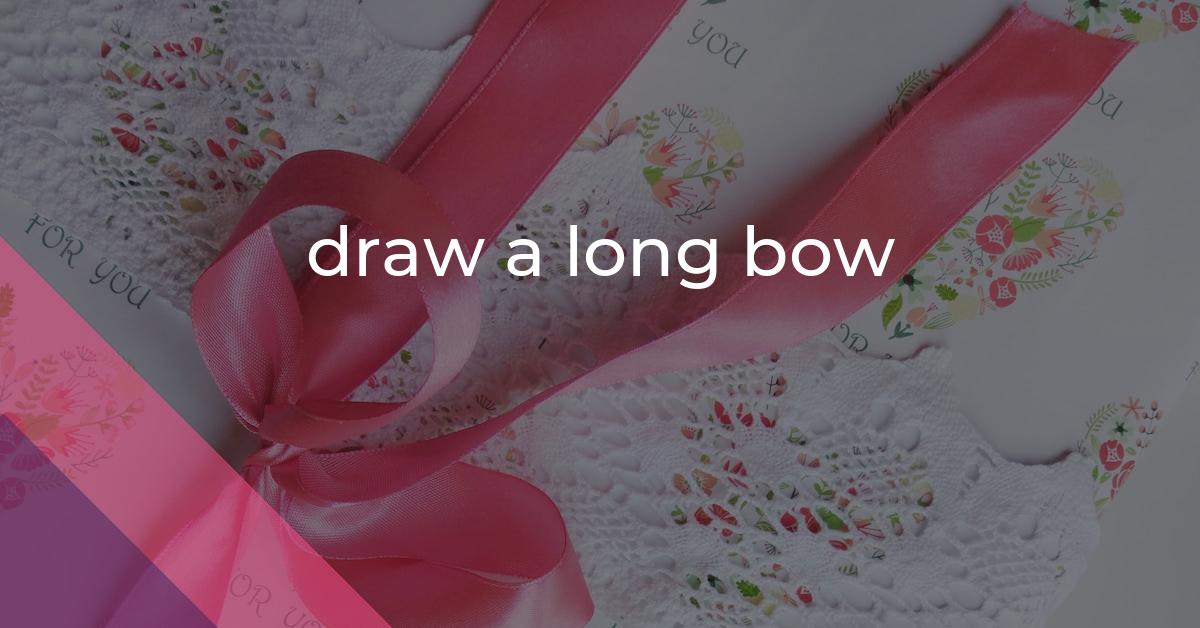draw a long bow: Idiom Meaning and Origin
What does ‘draw a long bow’ mean?
The idiom *draw a long bow* means to exaggerate or stretch the truth, often to make a story or claim more impressive or exciting.

Idiom Explorer
The idiom "lay it on thick" means to exaggerate or overdo something, especially when expressing emotions or flattery, in order to create a stronger impact or influence on someone.
The idiom "jump through hoops" means to go to great lengths or make a considerable effort to achieve or satisfy someone's demands or expectations.
The idiom "go to the bow-wows" means to deteriorate or decline in a significant way.
The idiom "go overboard" means to go to great or excessive lengths, often beyond what is necessary or reasonable. It implies an extreme or exaggerated action or behavior, often resulting from enthusiasm or excitement.
The idiom "go far" means to achieve great success or make significant progress in one's endeavors or career.
The idiom "draw the short straw" means to be chosen or assigned for an undesirable task or outcome, typically due to bad luck or random selection.
The idiom "draw the long bow" means to exaggerate or stretch the truth excessively. It is often used to describe someone who tells implausible or unbelievable stories.
The idiom "draw the line" means to set a limit or establish a boundary beyond which one is unwilling to go or accept.
The idiom "drawing card" refers to something or someone that attracts a large audience or customers.
Arcane Origins
"draw the long bow" is another idiomatic expression that is related to "draw a long bow." It means to exaggerate or tell tall tales, similar to the original phrase. However, "draw the long bow" has a slightly different connotation. It suggests that the speaker is not only stretching the truth but doing so in a way that is particularly extravagant or audacious. It implies a level of showmanship or grandiosity in the storytelling, as if the speaker is trying to impress or entertain their audience.
Another related idiom is "draw a line," which means to establish a boundary or set a limit. This phrase is quite different from "draw a long bow," but they share the common usage of the word "draw" to indicate an action of marking or creating something. While "draw a line" is not directly related to archery like the other idioms, it still carries a sense of precision and intentionality. When someone says they are "drawing a line," they are asserting their position or making it clear where they stand on a particular issue.
When something "goes a long way," it means that it has a significant impact or produces a large result. This idiom is different from the others in that it does not involve the act of drawing or shooting a bow. However, it shares the idea of distance or extent. Just as drawing a long bow allows an arrow to travel a great distance, something that "goes a long way" has a far-reaching effect or influence. It suggests that even a small action or gesture can have a profound and lasting impact.
Lastly, there is the idiom "draw a straight furrow." This phrase comes from the world of agriculture and describes the act of plowing a field in a straight line. It signifies precision, accuracy, and attention to detail. When someone is said to "draw a straight furrow," it means that they are focused and meticulous in their work. This idiom is quite different from the others, as it does not involve exaggeration or storytelling. However, it still shares the theme of skill and proficiency, which is also present in the original idiom, "draw a long bow."
When we consider these related idioms alongside "draw a long bow," it becomes clear that they all have a common thread. They all involve an action or skill that requires practice, precision, and a certain level of expertise. Whether it's pulling back a bowstring, establishing a boundary, making an impact, or plowing a straight line, these idioms speak to the power of intentionality and proficiency in our words and actions.
Language is a means of communication, and idioms like "draw a long bow" and its related phrases provide us with rich, evocative ways to express ourselves. They add color and depth to our conversations and allow us to convey complex ideas and emotions in a succinct and memorable way. As an experienced editor, it is my role to not only ensure that articles are clear, coherent, and effective, but also to recognize and appreciate the nuances and intricacies of language that idioms bring to the table. By following the rules of AP style and employing various editing techniques, I can help transform articles into engaging and impactful pieces of writing.
Idiomatic expressions like "draw a long bow" and its related phrases are an integral part of the English language. They allow us to communicate in a way that is both efficient and expressive, capturing the richness and complexity of human experience. By understanding the origins and meanings of these idioms, we gain insight into the cultural, historical, and linguistic connections that shape our language. As an editor, I take pride in my ability to improve articles by ensuring clarity, coherence, and effectiveness, while also honoring the unique and valuable contributions that idiomatic language brings to the table.
Example usage
Examples of how the idiom draw a long bow can be used in a sentence:
- He tends to draw a long bow when it comes to sharing his fishing stories.
- Her speech was filled with exaggerated claims, making it clear that she knows how to draw a long bow.
- The marketing team chose to draw a long bow by overpromising the benefits of their product.
More "Exaggeration" idioms



